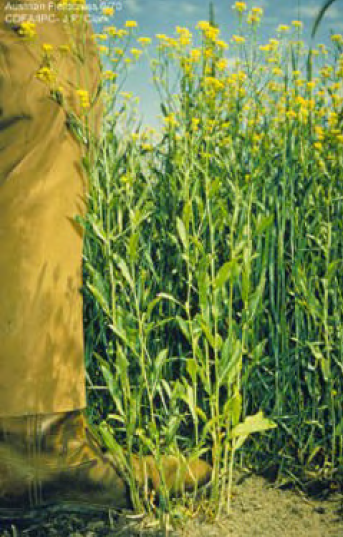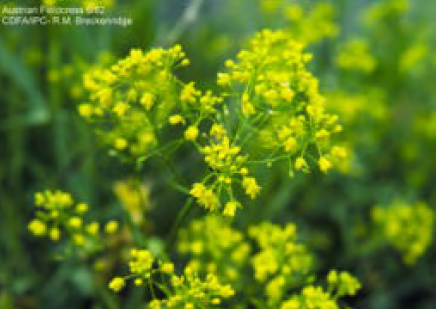Introduction
Austrian fieldcress is a noxious perennial weed of the mustard family (brassicaceae). Introduced from Europe, this aggressive weed has been found in southern Nevada. Though Austrian fieldcress is not widespread, its persistence makes it very troublesome.
Identification
The smooth stems of Austrian fieldcress (Rorippa austriaca) are nearly erect or ascending, branching at the top, and one to three feet tall (Fig. 1). The leaves are alternately arranged along the stem. They are dull green, narrowly oblong to narrowly wider near their tip than their base (oblanceolate) with smooth edges (entire) or occasionally unevenly toothed edges. The upper leaves taper to a stalk-like base that clasps the stem. The lowermost leaves are larger, have stalks (petioles), and are more conspicuously toothed than the upper leaves.

Figure 1. This plant grows 1 to 3 feet tall.
The yellow flowers grow in loose clusters at the tips of branches. They have four small petals and six stamens (Fig. 2). The seedpods are small, almost spherical or oblong, with a distinct beak at the tip. The small, rough, brown to black seeds generally do not develop in the northern regions or at high elevations where growing seasons are short, less than 100 days.
This plant mainly reproduces vegetatively by creeping roots, and rarely by seed. The thick, fleshy taproot has fine fibrous side roots and extensive creeping lateral roots that generate new shoots (Fig. 3). Buried root fragments can produce new plants.

Figure 2. Austrian fieldcress has clusters of yellow flowers borne at the tips of branches.
Habitat
Austrian fieldcress can be found in disturbed roadsides, fields (principally hay fields), and mud flats. It is rarely found in pastures, cultivated cropland, and undisturbed waste areas. This weed is usually associated with moist soils, riparian sites, and it typically inhabits areas where the soil is wet six to eight months of the year.
Impact
Austrian fieldcress is considered a problematic weed because of its perseverance and potential to outcompete native species. Its seeds are distributed by water, animals, people, agricultural equipment, and in mud and harvested crops. Seed production, however, is limited because few pods develop to maturity.
Reproduction by creeping roots is the primary means of spread of Austrian fieldcress. The roots are very persistent, and new plants may grow from small root fragments or detached adventitious roots that develop from stems in water. New plants largely establish in disturbed areas and are benefited by wet soils. There is a great potential for invasion along rivers and in wetlands when flooding takes place.

Figure 3. The creeping roots are the primary source of reproduction for Austrian fieldcress.
Weed Management Options
Prevention
Even though Austrian fieldcress is not widespread, there is great potential for invasion. Early detection of this very persistent weed is imperative because it is much more difficult to control once established.
Monitor both private and public lands annually for Austrian fieldcress invasions. Report its location to the landowner, gardener, manager, park ranger, or weed district. Eliminate it where it is found and then revisit the site each year to make sure there are no escapes. Although not common, Austrian fieldcress does spread by seed, so check for seeds on your clothing, shoes, animals, equipment, and vehicles before leaving an infested area. Also be aware that root fragments move in water, and both seed and plant parts may contaminate hay.
Mechanical Control
Hand pulling or digging of Austrian fieldcress can be effective, but can also potentially aid in its spread. When removing the plant by hand, make sure the entire root is removed and there are no fragments or seeds left behind. Place the entire plant in a bag and dispose of it properly in a landfill or by burning. These methods are only feasible for small infestations and a thorough job must be performed.
Cultural Control
Improving the drainage of wet soils, repeated cultivation, and crop rotation can help control Austrian fieldcress infestations in agricultural fields. Rotating to a cropping system that uses less water and permits thorough cultivation and herbicide application is most likely the best way to control this weed.
Biological Control
There are currently no known biological controls for Austrian fieldcress.
Chemical Control
Applying herbicides will produce results, and is most effective when combined with other methods. Applying 2,4-D after draining the infested area and executing an agricultural cropping program was successful in eradicating an infestation in California. Glyphosate can also be used for Austrian fieldcress control.
References
1. Rorippa Genus. CDFA Noxious Weed Index. 25 June 2003.
2. Austrian Fieldcress. University of Illinois Extension. 25 June 2003.
Pictures courtesy California Department of Food and Agriculture, Noxious Weed Photo Gallery.
Graham, J. and Johnson W.
2004,
Managing Austrian Fieldcress,
Extension | University of Nevada, Reno, FS-04-11


